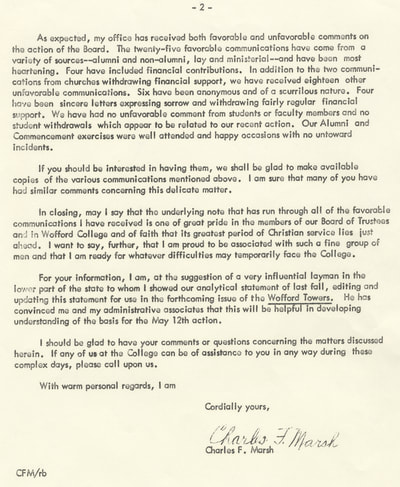More School Desegregation Orders Expected To Follow: Legal Experts Weigh In

Table of Contents
The Legal Basis for New Desegregation Orders
The foundation for current desegregation efforts rests on landmark legal precedents, most notably Brown v. Board of Education (1954). This Supreme Court case declared state laws establishing separate public schools for black and white students to be unconstitutional. The ruling fundamentally shifted the legal landscape, although its implementation faced, and continues to face, significant resistance.
- Key Supreme Court Cases: Brown v. Board of Education, Milliken v. Bradley (addressing interdistrict segregation), and subsequent cases have shaped the legal framework for addressing school segregation.
- Federal Laws: Title VI of the Civil Rights Act of 1964 prohibits discrimination based on race in programs receiving federal funding, while the Equal Educational Opportunities Act of 1974 specifically addresses school segregation.
- Department of Justice Role: The Department of Justice plays a crucial role in investigating and enforcing desegregation orders, often initiating lawsuits against school districts found to be in violation of federal law.
Understanding the distinction between de jure segregation (segregation by law) and de facto segregation (segregation in fact, often resulting from residential patterns) is vital. While de jure segregation is explicitly illegal, addressing de facto segregation presents more complex legal challenges, requiring courts to determine whether school districts are actively perpetuating segregation through their policies and practices.
Factors Contributing to the Predicted Increase in Desegregation Orders
The resurgence of school segregation, despite decades of legal efforts, is a complex issue with multiple contributing factors. This renewed focus on school desegregation is not coincidental; several factors are driving the predicted increase in orders.
-
Residential Segregation: Historically entrenched residential segregation patterns often lead to highly segregated school districts, creating a self-perpetuating cycle of inequality.
-
Funding Disparities: Unequal funding between school districts, often based on property taxes, exacerbates existing inequalities and reinforces segregation. Wealthier, predominantly white districts often have more resources, while poorer, often minority-majority districts struggle to provide adequate education.
-
School Choice Programs: While intended to improve educational opportunities, some school choice programs have inadvertently contributed to increased segregation by allowing students to select schools based on factors that inadvertently reinforce existing racial divisions.
-
Statistics: Data from the US Department of Education consistently shows that school segregation remains a significant problem in many parts of the country, with stark racial and socioeconomic disparities in school quality and resources.
-
Successful Lawsuits: Recent successful lawsuits in various states have highlighted the ongoing issue of school segregation and set precedents for future legal challenges. Examples include [insert examples of recent successful lawsuits].
-
Geographic Areas: Certain geographic areas, particularly in the South and some urban centers, are experiencing a rise in desegregation cases due to persistent segregation patterns and ongoing legal battles.
Expert Opinions and Legal Strategies
Legal experts anticipate a wave of new desegregation orders, citing the increasing number of lawsuits and the strengthening of legal precedents.
- Expert Quotes: "[Quote from a legal expert on the predicted increase in desegregation orders]," says [Expert's Name], a leading scholar in education law. "[Quote from another legal expert on the legal strategies being employed]," adds [Expert's Name].
- Plaintiff Strategies: Plaintiffs in these cases often employ strategies focusing on demonstrating a pattern of discriminatory practices by school districts, including analyzing student assignment policies, school resource allocation, and the impact of school choice programs.
- Defendant Strategies: Defendants often argue that current segregation is de facto, not de jure, and that they are not actively perpetuating segregation. They may also raise concerns about the feasibility and cost of implementing desegregation orders.
- Potential Remedies: Potential remedies sought in desegregation cases include busing, redrawing school boundaries, equitable funding allocations, and the implementation of programs aimed at promoting integration and addressing achievement gaps.
Challenges and Obstacles in Implementing Desegregation Orders
Even with successful legal challenges, implementing desegregation orders faces significant hurdles.
-
Community Resistance: Implementing desegregation plans often encounters strong community resistance, fueled by racial prejudice and anxieties about changing school demographics.
-
Financial Constraints: School districts, particularly those with limited resources, may struggle to afford the costs associated with implementing desegregation orders, such as busing or school renovations.
-
Logistical Difficulties: Busing students across significant distances presents logistical challenges, including increased travel time, traffic congestion, and concerns about student safety.
-
Past Experiences: Past desegregation efforts provide valuable lessons, highlighting the complexities of implementing meaningful change and the importance of community engagement and sustained support.
-
Potential Solutions: Addressing these obstacles requires creative solutions, including community dialogue, equitable funding mechanisms, and effective communication strategies to foster cooperation and understanding.
More School Desegregation Orders Expected to Follow: A Call to Action
The anticipated increase in school desegregation orders reflects a renewed focus on addressing systemic inequalities in education. This surge is rooted in established legal precedents, exacerbated by factors such as residential segregation and funding disparities, and supported by expert opinions predicting further legal challenges. Understanding the legal basis for these orders, the contributing factors, and the challenges of implementation is crucial for creating equitable educational opportunities for all students. Stay informed about the impact of these expected school desegregation orders and their implications for educational equity. For more information and resources, visit [Link to relevant organization or resource].

Featured Posts
-
 Understanding The Performance Of Riot Platforms Stock Riot Compared To Coinbase Coin
May 03, 2025
Understanding The Performance Of Riot Platforms Stock Riot Compared To Coinbase Coin
May 03, 2025 -
 Switzerlands Continued Backing Of Ukraine Presidents Firm Stance
May 03, 2025
Switzerlands Continued Backing Of Ukraine Presidents Firm Stance
May 03, 2025 -
 Lakazet S 157 Gola Lion Se Priblizhava Do Vrkha Vv Frantsiya
May 03, 2025
Lakazet S 157 Gola Lion Se Priblizhava Do Vrkha Vv Frantsiya
May 03, 2025 -
 Check The Bbc Two Hd Schedule For Newsround
May 03, 2025
Check The Bbc Two Hd Schedule For Newsround
May 03, 2025 -
 Ray Wsayl Alielam Alerbyt Fy Alhjwm Alisrayyly Ela Alqaflt Alinsanyt Qrb Malta
May 03, 2025
Ray Wsayl Alielam Alerbyt Fy Alhjwm Alisrayyly Ela Alqaflt Alinsanyt Qrb Malta
May 03, 2025
Latest Posts
-
 Largest Heat Pump System In Europe A Collaboration Between Innomotics Eneco And Johnson Controls
May 04, 2025
Largest Heat Pump System In Europe A Collaboration Between Innomotics Eneco And Johnson Controls
May 04, 2025 -
 Stockage D Energie Eneco Inaugure Un Parc De Batteries Geant A Au Roeulx
May 04, 2025
Stockage D Energie Eneco Inaugure Un Parc De Batteries Geant A Au Roeulx
May 04, 2025 -
 Record Breaking Heat Pump System Launched By Innomotics Eneco And Johnson Controls
May 04, 2025
Record Breaking Heat Pump System Launched By Innomotics Eneco And Johnson Controls
May 04, 2025 -
 Au Roeulx Eneco Lance Le Plus Grand Projet De Stockage D Energie De Belgique
May 04, 2025
Au Roeulx Eneco Lance Le Plus Grand Projet De Stockage D Energie De Belgique
May 04, 2025 -
 Eneco Innomotics And Johnson Controls Partner For Gigantic Heat Pump Project
May 04, 2025
Eneco Innomotics And Johnson Controls Partner For Gigantic Heat Pump Project
May 04, 2025
